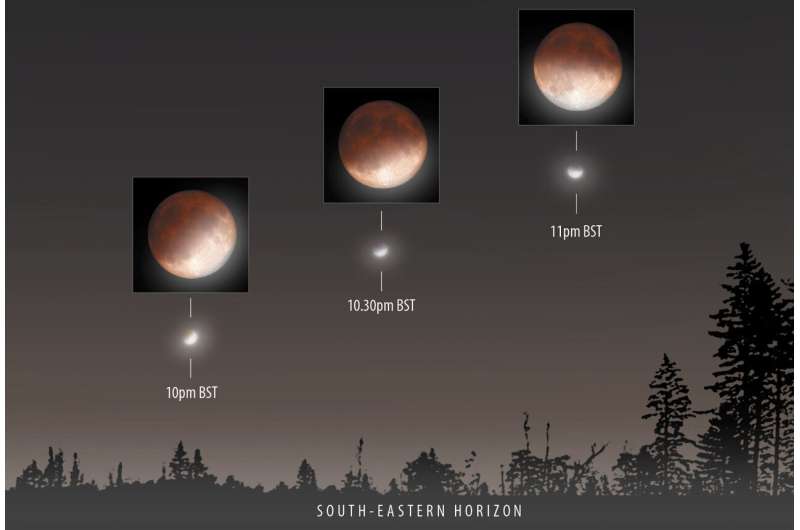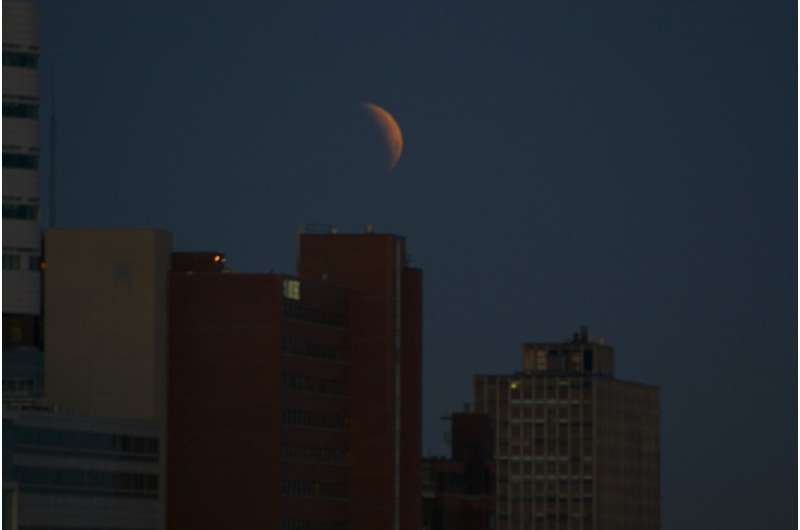An illustration of the 16 July lunar eclipse, illustrating the appearance of the Moon at different times, and the corresponding location of the Moon in the sky. Credit: Greg Smye-Rumsby / Astronomy Now
Tuesday, 16 July, will see a partial eclipse of the moon, visible in the U.K. after sunset. The eclipse, 50 years to the day after the launch of Apollo 11, will also be seen across a large part of Asia, the whole of Africa, the eastern part of South America, and the western part of Australia.
In a lunar eclipse, the Earth, sun, and moon are almost exactly in line and the moon is on the opposite side of the Earth from the sun. The moon is full, moves into the shadow of the Earth and dims dramatically but usually remains visible, lit by sunlight that passes through the Earth's atmosphere.
Stronger atmospheric scattering of blue light means that the light that reaches the lunar surface is predominantly red in colour, so for observers on Earth the eclipsed part of the moon may be brick-coloured, rusty, blood red, or sometimes dark grey, depending on terrestrial conditions.
The moon travels to a similar position every month at full moon, but the tilt of the lunar orbit means that it normally passes above or below the terrestrial shadow and no eclipse takes place.
In the coming eclipse, people in the U.K. will see the moon rise in the southeastern sky shortly after entering the darkest part of the Earth's shadow, the umbra. Moonrise is at 21:07 BST [20:07 UTC] in London, at 21:49 BST in Glasgow, and later further north and west. At moonrise, the partially eclipsed moon will be visible on the horizon in the southeast.
The partial phase of the lunar eclipse of 4 April 2015, as seen in Chicago. Credit: Nathan Mac / Wikicommons
Sunset in London that day will be 21:11 BST, and in Glasgow at 21:52 BST, so the moon will initially be seen in a bright twilight sky, in front of the stars of the constellation of Sagittarius. As the eclipse progresses more of the lunar surface will be in the darker shadow, with the remainder likely having a yellowish hue resulting from the lighter terrestrial shadow or penumbra.
Mid-eclipse is at 22:30 BST, when about 60 percent of the visible surface of the moon will be covered by the umbra. The moon leaves the darker shadow at midnight, and the eclipse ends when it exits the penumbra 79 minutes later.
In the U.K., the moon will be low throughout the eclipse, so watching it will need an unobstructed southeastern and southern horizon. But unlike a solar eclipse, the eclipsed moon is completely safe to look at with the naked eye, so can be enjoyed as a free and beautiful astronomical spectacle.
Provided by Royal Astronomical Society
























